DACF Home → Bureaus & Programs → Maine Natural Areas Program → Communities, Plants, and Animals → Invasive Plants → Ornamental Jewelweed
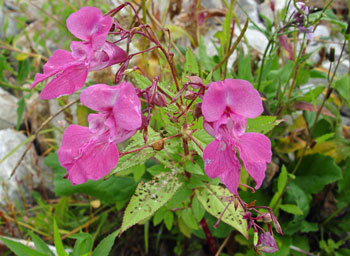 Ornamental jewelweed
Ornamental jewelweed
Ornamental Jewelweed
(Himalayan balsam, Pink jewelweed)
Impatiens glandulifera
2019 Status in Maine: Localized. Severely Invasive.
Description: Herbaceous annual. Tall, up to 6½' tall. Leaves: Simple, long tapering, pointed, 2-9" long and serrate; occurring opposite or in whorls of 3. Flowers: Conspicuous, large (1-2"), bilaterally symmetrical, pink to purple flowers are helmet shaped and appear from midsummer into fall. This species may attract bee pollinators away from native plants. Fruit: Seed pods are ¾-1½" long, taper at both ends, and contain 4-16 seeds. Like other "touch-me-nots" in the genus Impatiens, ripe pods explode when disturbed, ejecting seeds as far as 15' from the plant. Stem: Sturdy, hollow, and smooth; greenish to red.
Native range: Pakistan, India and Nepal. How arrived in U.S.: As an ornamental.
Reproduction: By seed. Seeds require cold stratification and are viable for about 2 years. Seeds from riparian populations can easily move downstream in sediments and soil from eroded river banks. Fallen plants can sprout roots from nodes along stem.
Habitat: Prefers moist soils, but can grow in a wide range of soils and at higher elevations. Common in riparian zones (stream and river shores), swales, and wet ditches along roadsides.
Similar native species: Spotted jewelweed (Impatiens capensis) and pale jewelweed (Impatiens pallida) are considerably smaller, have alternate, coarsely toothed, oval leaves, and orange and yellow flowers, respectively.
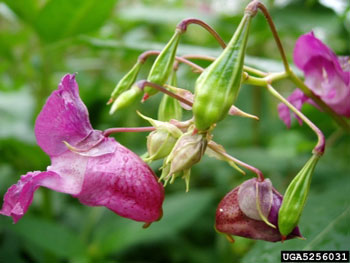 Ornamental jewelweed. Jan Samanek, Phytosanitary Administration, Bugwood.org
Ornamental jewelweed. Jan Samanek, Phytosanitary Administration, Bugwood.org
Similar non-native species: Hairy willow-herb (Epilobium hirsutum) could possibly be confused at a quick glance; it is a tall herb with pink flowers, but the flowers are radially symmetrical (vs. bilaterally symmetrical in jewelweed), and the stems are profusely hairy.
Fact Sheets and Identification Links
- Eco Sapiens, United Kingdom, Identification Video (3:50)
- Himalayan Balsam (Impatiens glandulifera) Fact Sheet, Alberta Invasive Species Council
- Go Botany page for Impatiens glandulifera
Control Methods
Hand pull, weed-whack, or mow before flowering.* Note that stems not uprooted can re-grow from nodes and still produce flowers and seeds. Monitor weed-whacked or mowed sites and repeat treatment as needed to prevent flowering. Sheep and cattle will graze it. Pulled plants with flowers should be bagged as trash because seed pods can continue to develop if plants are left on the ground. Fallen plants can also sprout shoots and roots from stem. Foliar spray of glyphosate † is effective when applied before flowering. If population is in a grassy area, use triclopyr, as it will not kill grasses. Special rules apply to herbicide use in or near wetlands and water bodies - consult the Maine Board of Pesticides Control.
* Correctly dispose of all plant parts↵ † Follow all label directions when using herbicides↵Control Technique Video Demonstrations
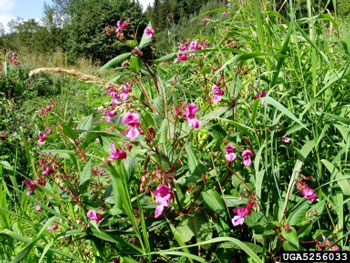 Ornamental jewelweed. Jan Samanek, Phytosanitary Administration, Bugwood.org
Ornamental jewelweed. Jan Samanek, Phytosanitary Administration, Bugwood.org
- Wilderness Tamed, United Kingdom (7:30), manual destruction and disposal
Please email invasives.mnap@maine.gov if you have questions about invasive species in Maine
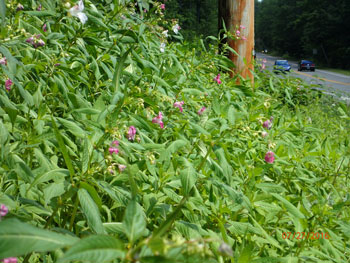 Ornamental jewelweed infestation
Ornamental jewelweed infestation
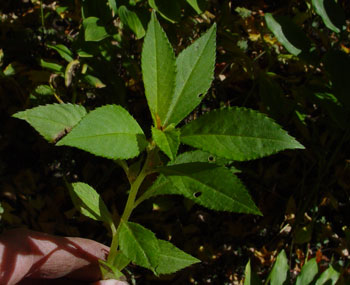 Ornamental jewelweed stem without flowers
Ornamental jewelweed stem without flowers
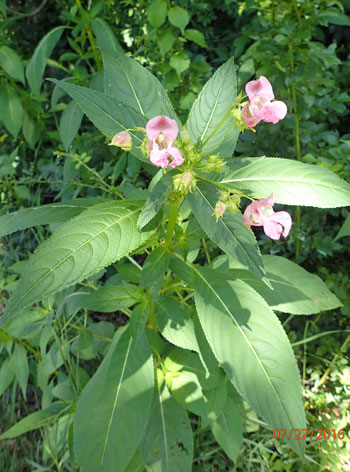 Ornamental jewelweed stem
Ornamental jewelweed stem
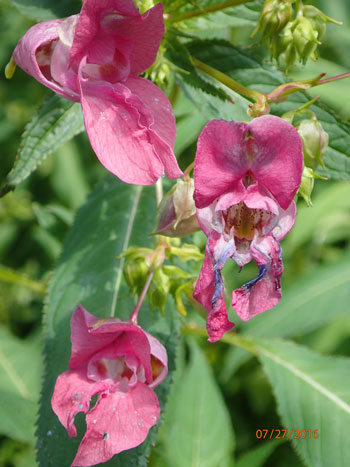 Ornamental jewelweed flowers
Ornamental jewelweed flowers